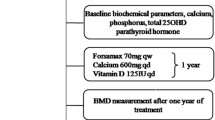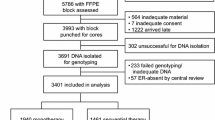Abstract
Adjuvant therapy for hormone receptor (HR) positive postmenopausal breast cancer patients includes aromatase inhibitors (AI). While both the non-steroidal AI letrozole and the steroidal AI exemestane decrease serum estrogen concentrations, there is evidence that exemestane may be less detrimental to bone. We hypothesized that single nucleotide polymorphisms (SNP) predict effects of AIs on bone turnover. Early stage HR-positive breast cancer patients were enrolled in a randomized trial of exemestane versus letrozole. Effects of AI on bone mineral density (BMD) and bone turnover markers (BTM), and associations between SNPs in 24 candidate genes and changes in BMD or BTM were determined. Of the 503 enrolled patients, paired BMD data were available for 123 and 101 patients treated with letrozole and exemestane, respectively, and paired BTM data were available for 175 and 173 patients, respectively. The mean change in lumbar spine BMD was significantly greater for letrozole-treated (−3.2 %) compared to exemestane-treated patients (−1.0 %) (p = 0.0016). Urine N-telopeptide was significantly increased in patients treated with exemestane (p = 0.001) but not letrozole. Two SNPs (rs4870061 and rs9322335) in ESR1 and one SNP (rs10140457) in ESR2 were associated with decreased BMD in letrozole-treated patients. In the exemestane-treated patients, SNPs in ESR1 (Rs2813543) and CYP19A1 (Rs6493497) were associated with decreased bone density. Exemestane had a less negative impact on bone density compared to letrozole, and the effects of AI therapy on bone may be impacted by genetic variants in the ER pathway.



Similar content being viewed by others
References
Dowsett M, Cuzick J, Ingle J, Coates A, Forbes J, Bliss J, Buyse M, Baum M, Buzdar A, Colleoni M et al (2010) Meta-analysis of breast cancer outcomes in adjuvant trials of aromatase inhibitors versus tamoxifen. J Clin Oncol 28(3):509–518
Burstein HJ, Temin S, Anderson H, Buchholz TA, Davidson NE, Gelmon KE, Giordano SH, Hudis CA, Rowden D, Solky AJ et al (2014) Adjuvant endocrine therapy for women with hormone receptor-positive breast cancer: American society of clinical oncology clinical practice guideline focused update. J Clin Oncol 32(21):2255–2269
Ingle JN (2013) Postmenopausal women with hormone receptor-positive breast cancer: balancing benefit and toxicity from aromatase inhibitors. Breast 22(Suppl 2):S180–S183
Chien AJ, Goss PE (2006) Aromatase inhibitors and bone health in women with breast cancer. J Clin Oncol 24(33):5305–5312
Rabaglio M, Sun Z, Price KN, Castiglione-Gertsch M, Hawle H, Thurlimann B, Mouridsen H, Campone M, Forbes JF, Paridaens RJ et al (2009) Bone fractures among postmenopausal patients with endocrine-responsive early breast cancer treated with 5 years of letrozole or tamoxifen in the BIG 1-98 trial. Ann Oncol 20(9):1489–1498
Perez EA, Josse RG, Pritchard KI, Ingle JN, Martino S, Findlay BP, Shenkier TN, Tozer RG, Palmer MJ, Shepherd LE et al (2006) Effect of letrozole versus placebo on bone mineral density in women with primary breast cancer completing 5 or more years of adjuvant tamoxifen: a companion study to NCIC CTG MA.17. J Clin Oncol 24(22):3629–3635
Goss PE, Strasser-Weippl K (2004) Aromatase inhibitors for chemoprevention. Best Pract Res Clin Endocrinol Metab 18(1):113–130
Goss PE, Hadji P, Subar M, Abreu P, Thomsen T, Banke-Bochita J (2007) Effects of steroidal and nonsteroidal aromatase inhibitors on markers of bone turnover in healthy postmenopausal women. Breast Cancer Res 9(4):R52
Lonning PE, Geisler J, Krag LE, Erikstein B, Bremnes Y, Hagen AI, Schlichting E, Lien EA, Ofjord ES, Paolini J et al (2005) Effects of exemestane administered for 2 years versus placebo on bone mineral density, bone biomarkers, and plasma lipids in patients with surgically resected early breast cancer. J Clin Oncol 23(22):5126–5137
Cigler T, Richardson H, Yaffe MJ, Fabian CJ, Johnston D, Ingle JN, Nassif E, Brunner RL, Wood ME, Pater JL et al (2011) A randomized, placebo-controlled trial (NCIC CTG MAP.2) examining the effects of exemestane on mammographic breast density, bone density, markers of bone metabolism and serum lipid levels in postmenopausal women. Breast Cancer Res Treat 126(2):453–461
Goss PE, Hershman DL, Cheung AM, Ingle JN, Khosla S, Stearns V, Chalchal H, Rowland K, Muss HB, Linden HM et al (2014) Effects of adjuvant exemestane versus anastrozole on bone mineral density for women with early breast cancer (MA.27B): a companion analysis of a randomised controlled trial. Lancet Oncol 15(4):474–482
Goss PE, Ingle JN, Pritchard KI, Ellis MJ, Sledge GW, Budd GT, Rabaglio M, Ansari RH, Johnson DB, Tozer R et al (2013) Exemestane versus anastrozole in postmenopausal women with early breast cancer: NCIC CTG MA.27–a randomized controlled phase III trial. J Clin Oncol 31(11):1398–1404
Colomer R, Monzo M, Tusquets I, Rifa J, Baena JM, Barnadas A, Calvo L, Carabantes F, Crespo C, Munoz M et al (2008) A single-nucleotide polymorphism in the aromatase gene is associated with the efficacy of the aromatase inhibitor letrozole in advanced breast carcinoma. Clin Cancer Res 14(3):811–816
Ingle JN, Schaid DJ, Goss PE, Liu M, Mushiroda T, Chapman JA, Kubo M, Jenkins GD, Batzler A, Shepherd L et al (2010) Genome-wide associations and functional genomic studies of musculoskeletal adverse events in women receiving aromatase inhibitors. J Clin Oncol 28(31):4674–4682
Liu M, Goss PE, Ingle JN, Kubo M, Furukawa Y, Batzler A, Jenkins GD, Carlson EE, Nakamura Y, Schaid DJ et al (2014) Aromatase inhibitor-associated bone fractures: a case-cohort GWAS and functional genomics. Mol Endocrinol 28:1740–1751
Mao JJ, Su HI, Feng R, Donelson ML, Aplenc R, Rebbeck TR, Stanczyk F, DeMichele A (2011) Association of functional polymorphisms in CYP19A1 with aromatase inhibitor associated arthralgia in breast cancer survivors. Breast Cancer Res 13(1):R8
Park IH, Lee YS, Lee KS, Kim SY, Hong SH, Jeong J, Lee H, Ro J, Nam BH (2011) Single nucleotide polymorphisms of CYP19A1 predict clinical outcomes and adverse events associated with letrozole in patients with metastatic breast cancer. Cancer Chemother Pharmacol 68(5):1263–1271
Wang L, Ellsworth KA, Moon I, Pelleymounter LL, Eckloff BW, Martin YN, Fridley BL, Jenkins GD, Batzler A, Suman VJ et al (2010) Functional genetic polymorphisms in the aromatase gene CYP19 vary the response of breast cancer patients to neoadjuvant therapy with aromatase inhibitors. Cancer Res 70(1):319–328
Henry NL, Azzouz F, Desta Z, Li L, Nguyen AT, Lemler S, Hayden J, Tarpinian K, Yakim E, Flockhart DA et al (2012) Predictors of aromatase inhibitor discontinuation as a result of treatment-emergent symptoms in early-stage breast cancer. Journal Clin Oncol 30(9):936–942
Henry NL, Skaar TC, Dantzer J, Li L, Kidwell K, Gersch C, Nguyen AT, Rae JM, Desta Z, Oesterreich S et al (2013) Genetic associations with toxicity-related discontinuation of aromatase inhibitor therapy for breast cancer. Breast Cancer Res Treat 138(3):807–816
Hangartner TN (2007) A study of the long-term precision of dual-energy X-ray absorptiometry bone densitometers and implications for the validity of the least-significant-change calculation. Osteoporos Int 18(4):513–523
Mathew A, Brufsky A (2014) The bone substudy of MA.27: does bone make a difference? Lancet Oncol 15(4):375–377
Dixon JM, Renshaw L, Young O, Murray J, Macaskill EJ, McHugh M, Folkerd E, Cameron DA, A’Hern RP, Dowsett M (2008) Letrozole suppresses plasma estradiol and estrone sulphate more completely than anastrozole in postmenopausal women with breast cancer. J Clin Oncol 26(10):1671–1676
Coleman RE, Banks LM, Girgis SI, Kilburn LS, Vrdoljak E, Fox J, Cawthorn SJ, Patel A, Snowdon CF, Hall E et al (2007) Skeletal effects of exemestane on bone-mineral density, bone biomarkers, and fracture incidence in postmenopausal women with early breast cancer participating in the intergroup exemestane study (IES): a randomised controlled study. Lancet Oncol 8(2):119–127
Eastell R, Adams JE, Coleman RE, Howell A, Hannon RA, Cuzick J, Mackey JR, Beckmann MW, Clack G (2008) Effect of anastrozole on bone mineral density: 5-year results from the anastrozole, tamoxifen, alone or in combination trial 18233230. J Clin Oncol 26(7):1051–1057
Eastell R, Hannon RA, Cuzick J, Dowsett M, Clack G, Adams JE (2006) Effect of an aromatase inhibitor on bmd and bone turnover markers: 2-year results of the anastrozole, tamoxifen, alone or in combination (ATAC) trial (18233230). J Bone Miner Res 21(8):1215–1223
Gaillard S, Stearns V (2011) Aromatase inhibitor-associated bone and musculoskeletal effects: new evidence defining etiology and strategies for management. Breast Cancer Res 13(2):205
Rozenberg S, Ham H, Bosson D, Peretz A, Robyn C (1990) Age, steroids and bone mineral content. Maturitas 12(2):137–143
Ducy P, Karsenty G (2010) The two faces of serotonin in bone biology. J Cell Biol 191(1):7–13
Napoli N, Rastelli A, Ma C, Yarramaneni J, Vattikutti S, Moskowitz G, Giri T, Mueller C, Kulkarny V, Qualls C et al (2013) Genetic polymorphism at Val80 (rs700518) of the CYP19A1 gene is associated with aromatase inhibitor associated bone loss in women with ER+ breast cancer. Bone 55(2):309–314
Rivadeneira F, Styrkarsdottir U, Estrada K, Halldorsson BV, Hsu YH, Richards JB, Zillikens MC, Kavvoura FK, Amin N, Aulchenko YS et al (2009) Twenty bone-mineral-density loci identified by large-scale meta-analysis of genome-wide association studies. Nat Genet 41(11):1199–1206
Hunter DJ, Kraft P, Jacobs KB, Cox DG, Yeager M, Hankinson SE, Wacholder S, Wang Z, Welch R, Hutchinson A et al (2007) A genome-wide association study identifies alleles in FGFR2 associated with risk of sporadic postmenopausal breast cancer. Nat Genet 39(7):870–874
Acknowledgments
We thank the patients who participated in the study, and the treating physicians, research nurses, and data managers at the three sites. This study was supported in part by a Pharmacogenetics Research Network Grant # U-01 GM61373 (DAF) and Clinical Pharmacology training grant: 5T32-GM08425 (DAF) from the National Institute of General Medical Sciences, National Institutes of Health (NIH), Bethesda, MD, and by grant numbers M01-RR000042 (UM), M01-RR00750 (IU), and M01-RR00052 (JHU) from the National Center for Research Resources (NCRR), and by R01-GM-099143 (JR, SO). The contents of the manuscript are solely the responsibility of the authors and do not necessarily represent the official views of NCRR or NIH. In addition, these studies were supported by grants from Pfizer, Inc. (DFH), Novartis Pharma AG (DFH), the Fashion Footwear Association of New York/QVC Presents Shoes on Sale™ (DFH), and BCRF. Study medication was provided by Pfizer, Inc. and Novartis Pharma AG. Authors’ roles: Study design: SO, NLH, TCS, VS, DFH, DAF. Study conduct and data collection: ATN, TCS, TNH, SP, MP, AMS, VS. NLH. Data analysis: KMK, LL, JD. Data interpretation: SO, NLH, TCS, VS, DFH, DAF, CHP, ATN, JMR, ZD. Drafting manuscript: SO, NLH. Revising manuscript content and approving final version of manuscript: All co-authors. SO, NLH, VS, DFH, and DAF take responsibility for the integrity of the data analysis.
Author information
Authors and Affiliations
Corresponding author
Ethics declarations
Conflict of Interest
NLH received research funding from AstraZeneca. DFH received research funding during the conduct of this trial from Novartis and Pfizer, and currently receives research funding from Veridex and Janssen Diagnostics. DAF receives research funding from Novartis and Pfizer and is a member of the Scientific Advisory Board for Quest Diagnostics, Inc. VS receives research funding from Abbott, Abraxis, Merck, Novartis, and Pfizer. JMR received a research grant from Pfizer. TNH receives research funding from Shire. TCS, JD, LL, KMK, CVP, CG, ATN, ZD, SO, SP, JSC, and AMS reported no conflicts of interest.
Additional information
Steffi Oesterreich and Henry N. Lynn share first authorship.
Electronic supplementary material
Below is the link to the electronic supplementary material.
Rights and permissions
About this article
Cite this article
Oesterreich, S., Henry, N.L., Kidwell, K.M. et al. Associations between genetic variants and the effect of letrozole and exemestane on bone mass and bone turnover. Breast Cancer Res Treat 154, 263–273 (2015). https://doi.org/10.1007/s10549-015-3608-8
Received:
Accepted:
Published:
Issue Date:
DOI: https://doi.org/10.1007/s10549-015-3608-8




